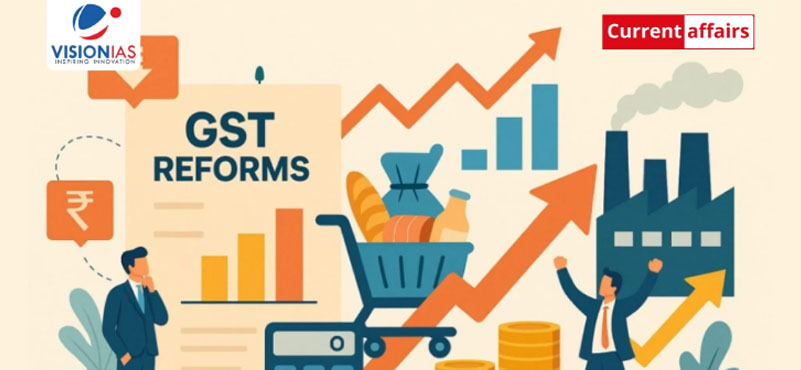Effective September 22, 2025, the Goods and Services Tax (GST) regime undergoes its most significant overhaul since its inception in 2017. India moves from a fragmented multi-slab structure to a more streamlined system comprising two principal slabs – 5% and 18%- with a steep 40% bracket retained only for a narrow “luxury/sin” list (select tobacco products, high-end automobiles, etc.). This structural rationalization, which occurred as a consequence of the recommendations of the 56th Meeting of the GST Council, marks a watershed in India’s indirect tax architecture, with extensive implications for households, businesses, fiscal federalism, and macroeconomic stability.
Why such reforms? Apart from the debilitating tariff hit to the Indian economy, there were compelling theoretical underpinnings and practical considerations. Kalidasa (500 CE) in his epic poem Raghuvamsham (1-18) states: “The King Dilip collects from his subjects only 1/6th of their income as tax for the welfare of State, indeed like the sun taking earthly water drops, only to indemnify her with multiples of rain-drops…”. Similarly, Chanakya, in his acclaimed work Arthashastra succinctly advises the rulers: “Collect taxes from the citizens as honeybees collect nectar from the flowers, gently and without inflicting pain…” Again, late Nani Palkhivala, who is widely considered to be one of India’s greatest lawyers ever, in the concluding paragraph of Preface to The Law and Practice of Income Tax, said, “Every Government has a right to levy taxes. But no Government has the right, in the process of extracting tax, to cause misery and harassment to the taxpayer and the gnawing feeling that he is made the victim of palpable injustice.” In other words, the case for low and stable taxes is unassailable and has been so across millennia, geographies, and, therefore, the Government needs to be complimented and congratulated for biting the bullet.
Let me also briefly refer to the Laffer Curve, which was popularized by economist Arthur Laffer (1974) for a comprehensive assessment and perspective. The Laffer Curve is an economic theory illustrated as an inverted U-shaped curve, showing the relationship between tax rates and government tax revenue. The theory posits that at a 0% tax rate, revenue is zero, and at a 100% tax rate, revenue is also zero because economic activity would cease. There is an optimal tax rate at the peak of the curve that maximizes government revenue
between 0% and 100% that maximizes government tax revenue. Laffer himself candidly acknowledged the influence of the 14th-century social philosopher Ibn Khaldun and others in the development of the concept.
India has one of the highest GST rates globally, leading to lower tax revenue efficiency and economic activity. High tax policies have deterred consumption, increased black market activities, and driven honest taxpayers and businesses out of the country. This vicious cycle of low incentives to work and earn, high taxes with attendant high tax evasion and tax avoidance
and feeble economic growth and structural transformation needs to be replaced by a virtuous cycle of high incentives to work and earn, low taxes with attendant low tax evasion and tax avoidance, and robust economic growth and structural transformation.
Three Pillars of GST Reforms:
Pillar 1: Structural Reforms:
- Inverted duty structure correction: Adjust input and output tax rates to reduce Input Tax Credit (ITC) accumulation and support domestic value addition.
- Resolving classification issues: Simplify rate structures, minimise disputes, simplify compliance, and ensure equity across sectors.
- Stability & predictability: Offer long-term clarity on rates and policies to build industry confidence and aid business planning.
Pillar 2: Rate Rationalisation:
- Lower taxes on essentials & aspirational goods: This will improve affordability, boost consumption, and expand access.
- Reduction of GST slabs: Move towards two main GST slabs – standard and merit, with special rates only for a few items.
- Compensation cess: Its removal creates fiscal space for rationalising and aligning tax rates sustainably.
Pillar 3: Ease of Living:
- Registration: Smooth, tech-based, and time-bound, especially for MSMEs and startups.
- Return: Pre-filled GST returns to cut manual work and mismatches.
- Refund: Quicker, automated GST refunds for exporters and inverted duty cases.
Structural Simplification: From Complexity to Clarity
- Consolidation: The shift from four effective slabs (5%, 12%, 18%, 28% plus cess) to two broad rates eliminates overlapping categories, grey areas, and disputes around classification.
- Taxpayer relief: MSMEs, who faced chronic compliance friction in distinguishing inputs and outputs across multiple slabs, now operate in a simpler ecosystem, with reduced litigation, compliance costs, and working capital blockages.
- Formalization boost: Lower complexity enhances voluntary compliance, widens the tax base, and curbs tax arbitrage.
Household & Sectoral Implications
Relief for Consumers
- Daily consumption basket cheaper: Food items, toiletries, select medicines, dairy products, and several FMCG categories are now uniformly taxed at 5% or 18%, lowering effective retail prices.
- Housing & infrastructure push: Cement-previously in the higher slab-has moved to 18%, reducing costs for construction, infrastructure, and real estate, improving housing affordability.
- Insurance boost: Exemption of life and health insurance premiums from GST not only provides direct relief but also aligns with broader financial inclusion and social protection objectives.
Pressure Points
- Energy shock: Coal faces a higher tax incidence, raising costs for power producers and heavy industries. The extent of pass-through to end-users depends on state-specific fuel mixes and DISCOM absorption capacity.
- Mid-premium apparel hit: Garments above defined price thresholds fall into higher tax categories, moderating demand in the mid-premium fashion segment.
Macroeconomic Impact
Inflation & Consumption
- Disinflationary impulse: The net price impact is expected to shave off up to ~1.1 percentage points from headline CPI, assuming effective pass-through by producers and retailers.
- Real income effect: Lower inflation boosts household purchasing power, supporting discretionary consumption during the festive season.
- Demand multiplier: Autos, appliances, FMCG, and consumer durables stand to benefit most, with potential demand spillovers to services and logistics.
Growth Outlook
- A simpler, more predictable tax regime supports investment sentiment, strengthens ease of doing business, and nudges further formalization.
- If consumption impulses sustain, the reforms could add 100–120 bps to GDP growth in FY26, reinforcing India’s position as the fastest-growing major economy.
Fiscal Trade-offs
- Gross revenue impact: Estimated at ~₹48,000 crore (₹480 billion) in FY26 due to lower rates on several categories.
- Net shortfall: Expected to moderate to ~₹22,000–24,000 crore, cushioned by higher compliance and buoyancy from stronger demand.
- Deficit dynamics: The Centre may absorb part of the shortfall, but if generous compensation to states is offered, overall general government deficit pressures could intensify in FY26 unless offset through expenditure rationalization or higher non-tax revenues.
Centre–State Dynamics: Cooperative Federalism Tested
- State concerns: Several states, across party lines, have argued for a guaranteed growth-linked compensation framework to offset potential revenue losses. Their fiscal space is already constrained by burgeoning welfare commitments and rising debt servicing.
- Compensation cess continuity: While the cess (primarily on tobacco) continues until past borrowings are cleared, its scope is far narrower than the earlier, expansive compensation mechanism. States thus face greater revenue volatility. The GST Council dispensed with the compensation cess because such a cess would have diluted the rate rationalisation and simplification efforts and is best eschewed. The States would examine their own revenue sources, as well as the 16th Finance Commission, to offset the losses they face.
- Negotiation imperative: The Centre–State equation will hinge on designing a predictable, rules-based compensation framework that balances fiscal stability with reform momentum.
Sectoral Nuances
- Automobiles & Durables: Mass-market segments benefit from lower effective incidence, while luxury autos remain in the 40% bracket. Expect a volume uptick in two-wheelers, passenger cars, and white goods.
- FMCG: Lower incidence in several categories, combined with rural recovery, is expected to drive broad-based growth.
- Construction & Real Estate: Cement at 18% reduces project costs, aiding affordable housing, infrastructure rollout, and private capex viability.
- Energy & Heavy Industry: Coal-linked cost escalations may raise tariffs regionally, potentially neutralizing some household savings. Energy-intensive industries (steel, aluminium, cement itself) may see higher input costs despite lower GST on outputs.
- Insurance & Financial Services: GST-free life and health insurance premiums support deeper penetration, reducing out-of-pocket risks for households.
Macro Trade-offs: The Balancing Act
Positives
- Simplified tax structure → reduced disputes, enhanced compliance, greater certainty.
- Lower inflation trajectory → higher real incomes, stronger consumption.
- Formalization tailwinds → medium-term revenue buoyancy and GDP support.
Risks
- Short-term fiscal drag until compliance-driven buoyancy materializes.
- State-level revenue stress could trigger political contestation and demands for prolonged compensation.
- Sector-specific cost push (coal, apparel) could partly offset disinflationary effects.
Five Strategic Takeaways
- Structural Simplification: India finally converges on a two-rate GST structure (5% & 18%), with a narrow 40% band for luxury/sin goods.
- Household Relief: Most consumption baskets turn cheaper; insurance premiums are tax-free, boosting disposable income.
- Macroeconomic Impulse: CPI inflation eases, real incomes rise, and consumption accelerates—potentially lifting GDP growth by 100–120 bps in FY26.
- Fiscal Federalism Stress Test: Gross revenue foregone (~₹48k crore) partly offset by buoyancy, but states demand stronger compensation safeguards.
- Net Effect: Reform is mildly pro-growth, with sectoral winners (autos, FMCG, construction) and pockets of pain (coal-linked utilities, mid-premium apparel).
The Road Ahead
The success of this reform hinges on two critical variables:
- Extent of price pass-through: Full transmission of lower taxes to consumers is essential for demand impulses and GST buoyancy.
- Centre–State fiscal compact: A durable, rules-based compensation framework is needed to balance state revenue stability with reform momentum.
The new GST 2.0 still has some anomalies and is still more complicated than it needs to be. But the removal of duty inversions and the easing of paperwork mark a considerable improvement. With a more efficient, transparent, and growth-focused tax system, the 2025 GST reforms could signify not just a tax simplification milestone but also a structural pivot towards higher growth, lower inflation, and deeper formalization of the Indian economy.
If all of us can individually and collectively implement all these measures, we can significantly upscale our performance. It is not great things that make life; it is just the sum of small things. In the words of Shiv Khera, “winners don’t do different things; winners do things differently”. It is this ability to do things differently, to think out of the box, that we must adopt to move to the next level. As Ram Dhari Singh Dinkar possibly Hindi’s greatest poet, wrote eloquently way back in 1946,
“सेनानी! करो प्रयाण अभय,
भावी इतिहास तुम्हारा है;
ये नखत अमा के बुझते हैं,
सारा आकाश तुम्हारा है।“
An English translation of these lines could be:
“Warrior! March ahead fearlessly,
The future history belongs to you;
These stars of darkness are fading,
The entire sky is yours.”
ABOUT THE AUTHOR
 Dr. Manoranjan Sharma is Chief Economist, Infomerics, India. With a brilliant academic record, he has over 250 publications and six books. His views have been cited in the Associated Press, New York; Dow Jones, New York; International Herald Tribune, New York; Wall Street Journal, New York.
Dr. Manoranjan Sharma is Chief Economist, Infomerics, India. With a brilliant academic record, he has over 250 publications and six books. His views have been cited in the Associated Press, New York; Dow Jones, New York; International Herald Tribune, New York; Wall Street Journal, New York.








